15-2 Our observations show us that the universe is expanding
During the 1920s, Edwin Hubble, working with Milton Humason, photographed the spectra of many galaxies with the 100-in. (2.5-m) telescope on Mount Wilson in California. To their great surprise, they found that the measured spectral line positions were often not located exactly where they expected them to be. Rather, they found that spectral line positions were often shifted toward the red end of the spectrum. Recall from studying the Doppler effect that spectral lines from glowing objects that are moving away from Earth exhibit a redshift toward longer wavelength positions. Observing the redshifted spectral lines from the galaxies, they found that most galaxies are moving away from Earth.
A second set of observations added to the story line. Hubble made measurements of the fluctuating apparent brightnesses and pulsation periods of Cepheid variables in these galaxies. Using the Cepheid variables as standard candles allowed Hubble and Humason to estimate the distance to each galaxy. To their great surprise, they found a direct correlation between the distance to a galaxy and its redshift. This general rule is one of the most important in astronomy and can be summarized as
The more distant a galaxy, the greater its redshift and the more rapidly the distance between us is increasing.
In other words, nearby galaxies are moving away from us slowly, and more distant galaxies appear to be rushing away from us much more rapidly. Figure 15-2 shows this relationship for five representative elliptical galaxies. These observations lead us to an inescapable conclusion—our universe is expanding.
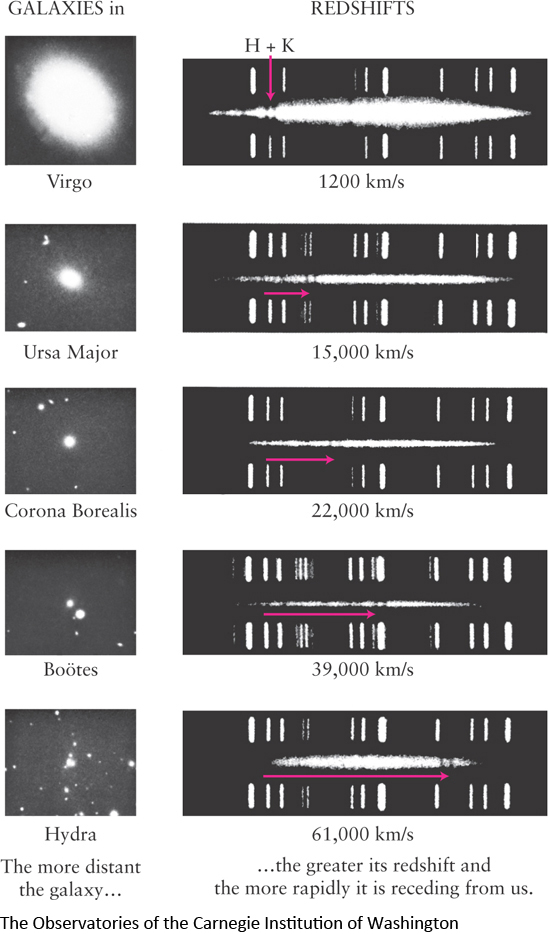
ANALOGY
What does it actually mean to say that the universe is expanding? According to general relativity, space itself is not rigid. The amount of space between widely separated locations changes over time. A good analogy is that of baking a chocolate chip cake, as in Figure 15-3. As the cake expands during baking, the amount of space between the chocolate chips gets larger and larger. In the same way, as the universe expands, the amount of space between widely separated galaxies increases. The expansion of the universe is the expansion of space.

CAUTION
It is important to realize that the expansion of the universe occurs primarily in the vast spaces that separate clusters of galaxies. Just as the chocolate chips in Figure 15-3 do not expand as the cake expands during baking, galaxies themselves do not expand. Einstein and others have established that an object that is held together by its own gravity, such as a galaxy or a cluster of galaxies, is always contained within a patch of nonexpanding space. A galaxy’s gravitational field produces this nonexpanding region, which is indistinguishable from the rigid space described by Newton. Thus, Earth and your body, for example, are not getting any bigger. Only the distance between widely separated galaxies increases with time. Cosmic Connections: “Urban Legends” about the Expanding Universe has more to say about several misconceptions concerning the expanding universe.
362
COSMIC CONNECTIONS “Urban Legends” about the Expanding Universe
There are a number of common misconceptions or “urban legends” about what happens as the universe expands. The illustrations below depict the myth and the reality for three of these “urban legends.”
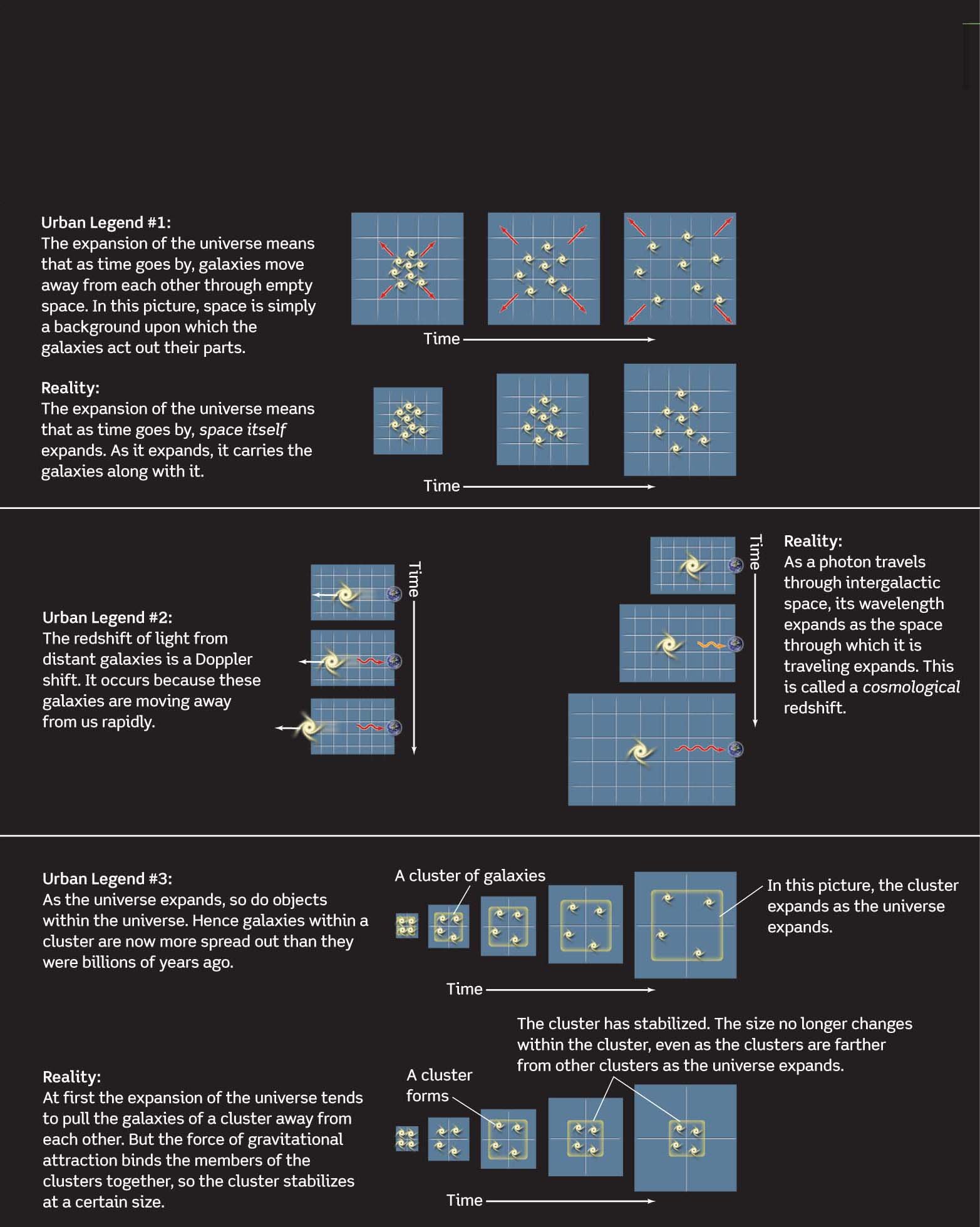
363
This notion has critically important implications for Olbers’s paradox presented in the first section of this chapter. If the universe is expanding, then some stars and galaxies are so far away that their light has not yet had time to travel through space to get here!
Question
ConceptCheck 15-2: Although nearly all distant galaxies have measureable redshifts, the relatively nearby Andromeda Galaxy exhibits an overall blue shift. What does this mean about the Andromeda Galaxy’s movement?
Redshift of a Receding Object
Hubble estimated the distances to a number of galaxies and the redshifts of those galaxies. We can write a straightforward mathematical relationship between how much a spectral line position has shifted compared to its expected position. We call this ratio a galaxy’s redshift, denoted by the symbol z. Using a calculator, this is found by taking the wavelength (λ) observed for a given spectral line, subtracting from it the ordinary, unshifted wavelength of that line (λ0) to get the wavelength difference (Δλ), and then dividing that difference by λ0:


Astronomers often express the distance to a remote galaxy simply in terms of its redshift z (which can be measured very accurately). For example, an astronomer might simply say that a certain galaxy is “at z = 0.128” by making use of the following general rule:
The greater the redshift of a distant galaxy, the greater its distance.
This relationship between the distances to galaxies and their redshifts was one of the most important astronomical discoveries of the twentieth century. In 1929, Hubble published this discovery, which is now known as the Hubble law. The Hubble law is that there is a direct relationship between a galaxy’s distance and velocity—distant objects are seen to be moving away faster—and is easily stated as a formula:
The Hubble law
ν = H0d

This formula is the equation for the straight line displayed in Figure 15-4, and the Hubble constant H0 is the slope of this straight line. To make the calculations easier, we often measure speeds in kilometers per seconds, rather than miles per hour, and distances in megaparsecs, rather than millions of light years—recall that a megaparsec is 3.26 million ly. From the data plotted on this graph we find that H0 = 73 km/s/Mpc (say “73 kilometers per second per megaparsec”). In other words, for each million parsecs to a galaxy, the galaxy’s speed away from us increases by 73 km/s. For example, a galaxy located 100 million parsecs from Earth should be rushing away from us with a speed of 7300 km/s. (In other books you may see the units of the Hubble constant written with exponents: 73 km s−1 Mpc−1.)
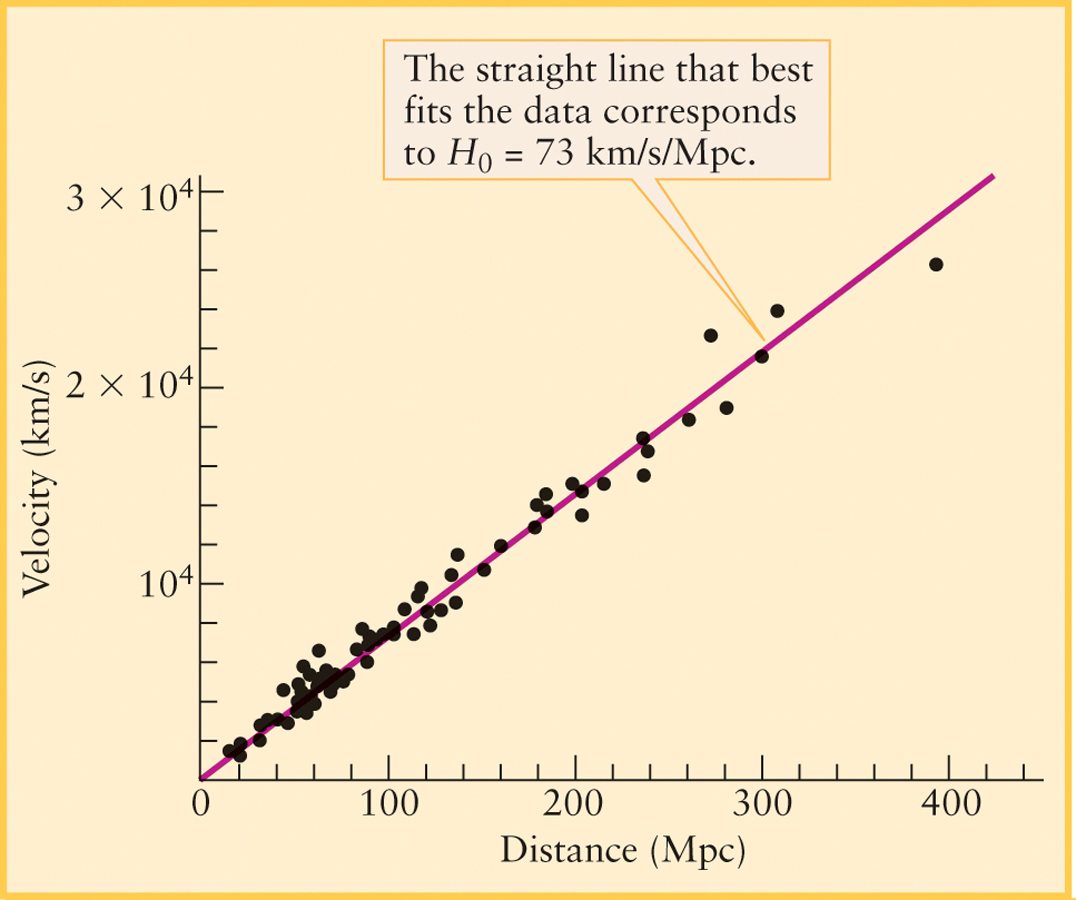
Determining the value of H0 has been an important task of astronomers for a very simple reason: The Hubble constant is one of the most important numbers in all astronomy. It expresses the rate at which the universe is expanding and helps estimate the age of the universe. Furthermore, the Hubble law can be used to determine the distances to extremely remote galaxies. If the redshift of a galaxy is known, the Hubble law can be used to determine its distance from Earth.
 Go to Video 15-1
Go to Video 15-1
The Hubble law is a direct proportionality—that is, a galaxy twice as far away is receding from us twice as fast. This is just what we would expect in an expanding universe. To see why this is so, imagine a grid of parallel lines (as on a piece of graph paper) crisscrossing the universe. Figure 15-5a shows a series of such gridlines 100 Mpc (326 million ly) apart, along with five galaxies labeled A, B, C, D, and E that happen to lie where gridlines cross. As the universe expands in all directions, the gridlines and the attached galaxies spread apart. (This is just what would happen if the universe were a two-dimensional rubber sheet that was being pulled equally on all sides. Alternatively, you can imagine that Figure 15-5a depicts a very small portion of the chocolate chip cake in Figure 15-3, with galaxies taking the place of chocolate chips.)
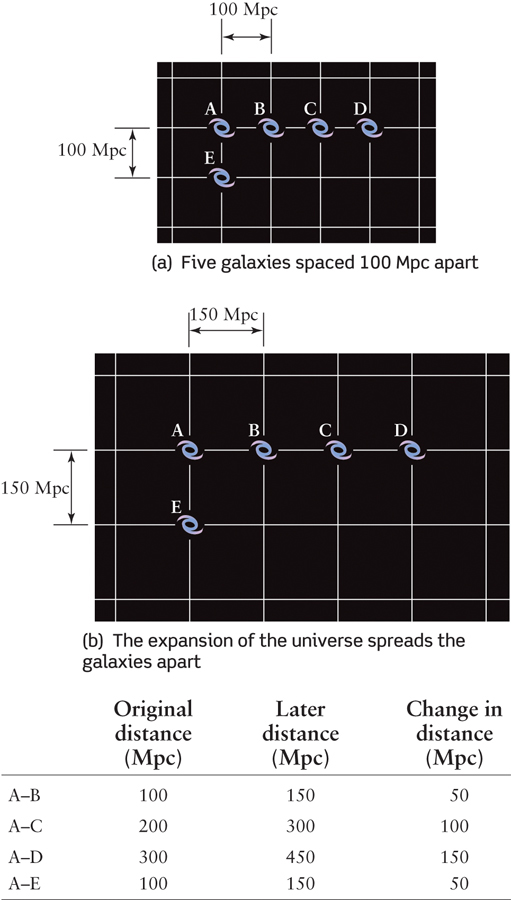
364
| Original distance (Mpc) | Later distance (Mpc) | Change in distance (Mpc) | |
|---|---|---|---|
| A–B | 100 | 150 | 50 |
| A–C | 200 | 300 | 100 |
| A–D | 300 | 450 | 150 |
| A–E | 100 | 150 | 50 |
The greater the redshift of a distant galaxy, the greater its distance.
Figure 15-5b shows the universe at a later time, when the gridlines are 50% farther apart (150 Mpc) and all the distances between galaxies are 50% greater than in Figure 15-5a. Imagine that A represents our Galaxy, the Milky Way. The table accompanying Figure 15-5 shows how far each of the other galaxies has moved away from us during the expansion: Galaxies A and B and galaxies A and E were originally 100 Mpc apart, and have moved away from each other by an additional 50 Mpc; galaxies A and C, which were originally 200 Mpc apart, have increased their separation by an additional 100 Mpc; and the distance between galaxies A and D, originally 300 Mpc, has increased by an additional 150 Mpc. In other words, the increase in distance between any pair of galaxies is in direct proportion to the original distance; if the original distance is twice as great, the increase in distance is also twice as great.
CAUTION
It may seem that if the universe is expanding, and if we see all the distant galaxies rushing away from us, then we must be in a special position at the very center of the universe. In fact, the expansion of the universe looks the same from the vantage point of any galaxy. For example, as seen from galaxy D in Figure 15-5, the initial distances to galaxies A, B, and C are 300 Mpc, 200 Mpc, and 100 Mpc, respectively. Between parts a and b of the figure, these distances increase by 150 Mpc, 100 Mpc, and 50 Mpc, respectively. So, as seen from galaxy D as well, the recessional velocity increases in direct proportion with the distance, and in the same proportion as seen from galaxy A. In other words, no matter which galaxy you call home, you will see all the other galaxies receding from you in accordance with the same Hubble law (and the same Hubble constant) that we observe from Earth.
Figure 15-3 also shows that the expansion of the universe looks the same from one galaxy as from any other. An insect sitting on any one of the chocolate chips would see all the other chips moving away. If the cake were infinitely long, it would not actually have a center; as seen from any chocolate chip within such a cake, the cake would extend off to infinity to the left and to the right, and the expansion of the cake would appear to be centered on that chip. Likewise, because every point in the universe appears to be at the center of the expansion, it follows that our universe has no center at all. (Later in this chapter we will see evidence that the universe, like our imaginary cake, is indeed infinite.)
CAUTION
“If the universe is expanding, what is it expanding into?” This commonly asked question arises only if we take our chocolate chip cake analogy too literally. In Figure 15-3, the cake (representing the universe) expands in three-dimensional space into the surrounding air. But the actual universe includes all space; there is nothing “beyond” it, because there is no “beyond.” Asking “What lies beyond the universe?” is as meaningless as asking “Where on Earth is north of the North Pole?”
The ongoing expansion of space explains why the light from remote galaxies is redshifted. Imagine a photon coming toward us from a distant galaxy. As the photon travels through space, the space is expanding, so the photon’s wavelength becomes stretched. When the photon reaches our eyes, we see an increased wavelength: The photon has been redshifted. The longer the photon’s journey, the more its wavelength will have been stretched. Thus, photons from distant galaxies have larger redshifts than those of photons from nearby galaxies, as expressed by the Hubble law. To be clear, a redshift caused by the expansion of the universe is properly called a cosmological redshift. It is not the same as a Doppler shift. Doppler shifts are caused by an object’s motion through space, whereas a cosmological redshift is caused by the expansion of space (Figure 15-6).
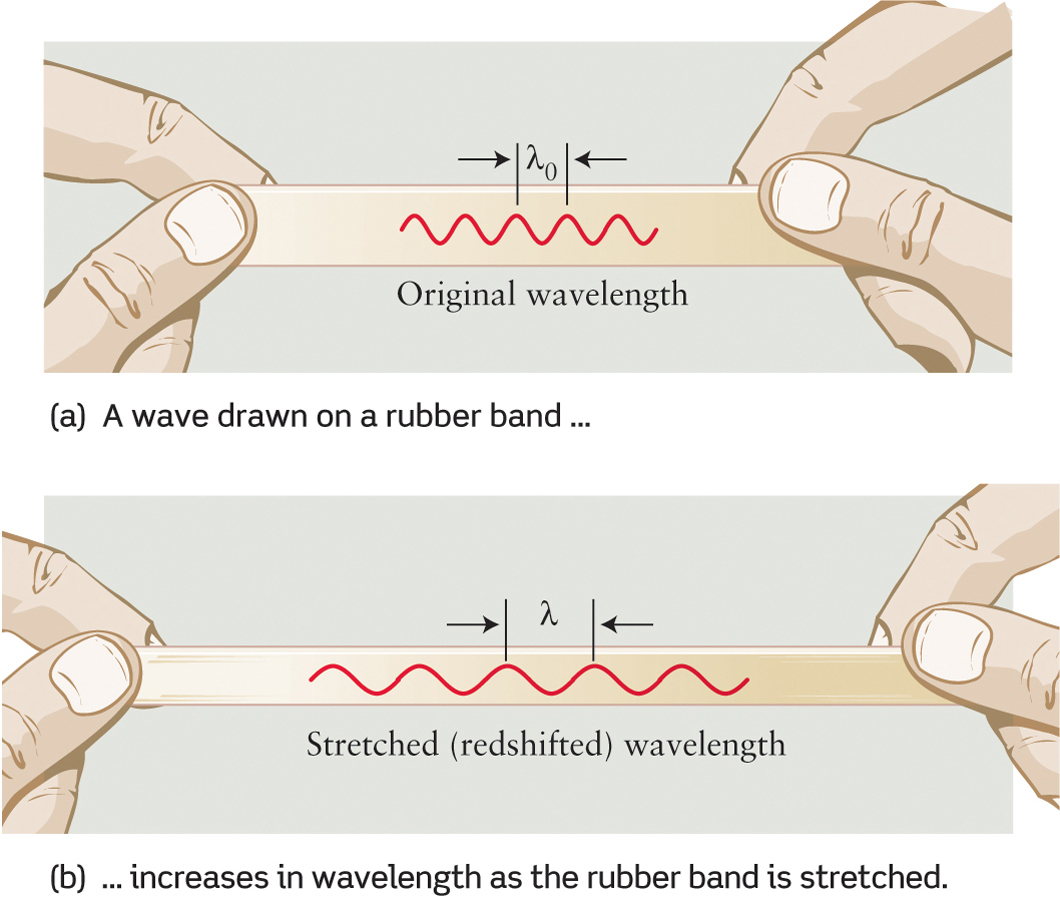
CAUTION
A common misconception about the Hubble law is that all galaxies are moving away from the Milky Way. The reality is that galaxies have their own motions relative to one another, thanks to their mutual gravitational attraction. For nearby galaxies, the speed of the Hubble flow is small compared to these intrinsic velocities. Hence, some of the nearest galaxies, including M31 (shown in Figure 14-2), are actually approaching us and have blueshifts rather than redshifts. But for distant galaxies, the Hubble speed ν = H0d is much greater than any intrinsic motion that the galaxies might have. Even if the intrinsic velocity of such a distant galaxy is toward the Milky Way, the fast-moving Hubble flow sweeps that galaxy away from us.
365
Question
ConceptCheck 15-3: What two observations about galaxies most strongly suggest that our universe is expanding?
Question
CalculationCheck 15-1: What is the redshift z-value for a galaxy that has a galaxy spectral line shifted to 725.6 nm when a stationary object would emit the line at 656.3 nm?
Question
CalculationCheck 15-2: What is the distance to a galaxy that is observed to have a recessional velocity of 10,000 km/s?
The Cosmological Principle
These ideas about the expanding universe demonstrate the central philosophy of cosmology. In cosmology, unlike other sciences, we cannot carry out controlled experiments or even make comparisons: There is only one universe that we can observe. To make progress in cosmology, we must accept certain philosophical assumptions or abandon hope of understanding the nature of the universe. The Hubble law provides a classic example. It could be interpreted to mean that we are at the center of the universe. We reject this interpretation, however, because it violates a cosmological extension of Copernicus’s belief that we do not occupy any particular special or privileged location in space.
When Einstein began applying his thinking to cosmology about a century ago, he made a daring assumption: Over very large distances the universe is homogeneous, meaning that every region is the same as every other region, and isotropic, meaning that the universe looks the same in every direction. In other words, if you could stand back and look at a very large region of space, any one part of the universe would look basically the same as any other part, with the same kinds of galaxies distributed through space in the same way. The assumption that the universe is homogeneous and isotropic constitutes the cosmological principle. It gives precise meaning to the idea that we do not occupy a special location in space.
Models of the universe based on the cosmological principle have proven remarkably successful in describing the structure and evolution of the universe and in interpreting observational data. All the discussion about the universe in this book assumes that the universe is homogeneous and isotropic on the largest scale.
Question
ConceptCheck 15-4: If we notice in the night sky that there are more stars along the Milky Way than in other regions of the sky, is this consistent or inconsistent with the cosmological principle?